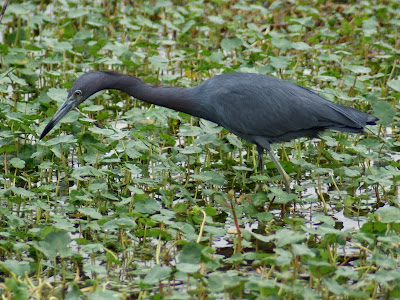.
As I haven't had time for birding this month, my 2011 bird list has been stagnating. So a week ago I popped over to Sheldon Lake in hopes of seeing some new year species. I was pretty sure that the environmental center ponds would have Yellow-crowned Herons and perhaps an American Bittern, while the wetland area behind is normally good for Snow Geese in the winter and the lake itself should have Northern Pintail.My first stop was at the (currently closed) parking area on Garrett Road. I struck out on Northern Pintail but was surprised to see more than a dozen Black-crowned Night Herons perching in the cypress trees. Unfortunately, they were too far away to photograph in the dim morning light.
My next stop was at a fishing pier halfway down Pineland Road. I was pleased to see that the surface of the water was clear of water hyacinth for the first time in years. I don't know whether the park authorities have been clearing away this very invasive plant or whether it was zapped by this winter's hard frosts.
The area had plenty of American Coots and Common Moorhens, as well as several Anhingas. The bushes along the side of the lake were busy with Red-winged Blackbirds, who were filling the air with their wonderful calls.
Down at the environmental center, the grassy areas were covered with American Robins but the ponds were empty of birds except for some White Ibis doing their morning grooming.
As I drove out to the wetlands area, a Savannah Sparrow jumped up to check me out.
I was so busy taking a photo of the sparrow that I missed a chance to ID several hundred ducks that suddenly took flight from a patch of water in the distance. Pity! I bet there were Northern Pintails among the birds that flew!
All was not lost, though. Another patch of water had a few dozen Snow Geese as well as a couple of Ross's Geese. They didn't flee at my approach and so I was able to examine them through binoculars. Most of the Snow Geese were white adults but there were also some dark adults (with their white heads and upper necks) and a handful of dark juveniles (all black or dark gray).
So my trip hadn't produced all the species I was looking for but it did turn up others I hadn't expected. That's often what happens when you go birding with specific birds in mind. My 2011 list has now reached 138 species, which is much better than I achieved in any previous year. I'd still like to see a Northern Pintail before the winter ends, though. They're such beautiful birds.
.



















































